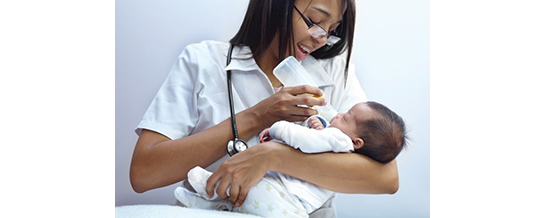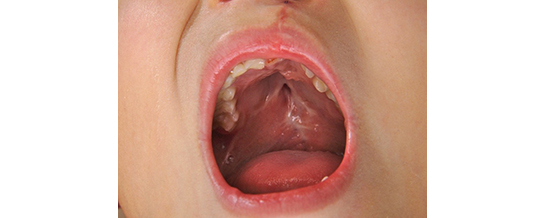Cleft Palate

What is a cleft palate?
A cleft palate is an opening or split in the roof of the mouth (palate). A cleft palate is a somewhat common condition found in newborn babies and can occur with a cleft lip (opening or split in the upper lip) or without a cleft lip.
There are a variety of different types of clefts that affect the soft and/or the hard palate. Clefts can range from partial to complete, or a combination of both. Your child’s doctor will discuss with you in more detail the type of cleft palate affecting your child.
What causes a cleft palate?
A cleft palate is a birth defect occasionally found in newborn babies. The cleft occurs when the structures of an unborn baby’s face do not close completely, while the baby is still in the womb. Most cleft palates develop with no known cause, and are more common in families with other members already affected. About 1 in 1000 children is born with a cleft palate.

What are the symptoms?
Babies born with a cleft palate do not feel any discomfort from their cleft. If the cleft palate occurs without a cleft lip, the cleft palate will only be noticeable by the appearance of a split or opening somewhere along the roof of the mouth. Sometimes a cleft palate can be difficult to see, even by a very experienced eye.
Many babies born with a cleft palate will have some difficulty feeding, and some will be unable to breastfeed. Please see “How does cleft palate affect feeding?” for more information on feeding your baby with a cleft palate.
How is it prevented?
Doctors do not know how to prevent a cleft palate from occurring. It is extremely rare that a cleft palate may be linked to a particular maternal exposure during pregnancy (for example: certain types of anti-seizure medicines, or folic acid deficiency). In fact, a cleft palate is almost never caused by anything that was done or not done by the parents or family during pregnancy.
How does cleft palate affect feeding?
Cleft palate can have a major impact on feeding. Many babies with a cleft palate are unable to breastfeed successfully. The wider the cleft, the more trouble a baby generally will have creating an effective suck. Special adjustments in the way you feed your baby may be necessary to help with feedings. Your doctor may ask the Occupational Therapist (OT) or Speech Language Pathologist (SLP) to be at your child’s first visit. The OT or SLP will perform a feeding assessment and offer guidance on how best to feed your baby.
If needed, they will provide special cleft feeders to help assist with feeding. If possible, please bring with you to your appointment the bottle and milk/formula that your baby uses at home.
How does cleft palate affect a baby’s ears?
Babies with cleft palate have an increased risk for problems with their Eustachian tube. The Eustachian tube connects the middle ear to the pharynx (throat), and is involved in the normal function of “popping” our ears when we change elevation.
This same function is important in maintaining proper pressure levels in the middle ear. Babies with cleft palate have a higher risk of middle ear pressure problems. Middle ear pressure can cause fluid to collect in the middle ear, which can lead to development of an ear infection.
Symptoms of middle ear pressure may include muffled sound, dulled hearing, and ear pain. Your child’s doctor will talk with you about placing pressure equalization tubes (PE tubes) in the ear during surgery to help decrease the development of middle ear problems.
How does cleft palate affect speech?
A key function of the palate (the soft palate, in particular) is to help with speech. The soft palate functions like a valve, controlling air flow out the mouth, and preventing excess air flow from escaping through the nose during speech. Children with a repaired cleft palate have an increased risk of having an unusually “nasal” sound to their speech (called “hypernasal resonance”). This occurs in between 15-25% of children. Speech therapy between the ages of 2-5 will often correct remaining cleft speech problems. Sometimes an additional surgery may be required during school age in order to help improve the valve-like function of the palate and improve speech. Your surgeon and speech pathologist will follow your child over the years after the cleft palate repair to assess his/her speech development.
How is it a cleft palate repaired?
A cleft palate develops with no known cause and does not close on its own. A baby born with a cleft palate will require surgery to close the opening in their palate. Your baby will be seen by the plastic surgeon in the hospital after he/she is born. The first office visit with the doctor will then occur shortly after birth.
At the first office visit, the plastic surgeon will do a careful exam of your baby and assess for any other medical problems. With your consent, pictures of your baby’s face and/or cleft palate may be taken at this time for his/her medical record.

Surgery for cleft palate
Surgery is required to close a cleft palate because it will not close on its own. It is important that the cleft be repaired because of its potential impact on feeding, ear infections, oral hygiene, and speech development. Surgery to repair the cleft is recommended or when the baby is between 9-15 months of age. Your child’s surgeon will discuss with you the best time to schedule the procedure for your baby.
The surgery usually takes approximately 2 hours to perform, and your baby will stay in the hospital 1-2 nights following surgery.
After surgery, your child’s surgeon will answer any questions you may have about the procedure.
Caring for your child after surgery
The medical team will assess your child’s pain and ability to feed successfully before allowing him/her to go home. Do not place objects in your child’s mouth for 4 weeks after surgery. This includes pacifiers and any type of chew toys. It is very important that the fragile repaired cleft palate area be left alone for 4 weeks after surgery. Stitches placed along the repair on the roof of the mouth are dissolvable and will either ‘disappear’ or fall out in the weeks after surgery.
Managing Pain
You may give your child paracetamol or ibuprofen in the recommended dose as needed for pain.
Do not give your child aspirin, as it may cause serious complications.
Diet
Will my child be able to eat after surgery?
Yes. Your health care provider will be present immediately following the surgery to assist with post-surgery feeding. Different feeding methods will be shared with you to help find the one that works best and to help reduce the possibility of injury to the newly repaired palate. There is not one feeding method that is best for all babies. Your health care provider will work with you to determine the best method for your baby.
What can my child eat after surgery?
For the first 3 weeks after surgery your child’s diet will be milk and/or formula only. After 3 weeks, unless advised otherwise by the surgeon, your child may begin to eat pureed foods (baby food, pudding, yogurt, apple sauce) for one week. Your child may return to their normal diet 4 weeks after surgery, unless advised otherwise by the surgeon.
When to seek medical help:
If your child has any of the following symptoms, speak to your child’s health-care provider or go to the emergency department
- A temperature of 38.5 degrees Celsius (100.4 degrees Fahrenheit) or higher
- Increased tenderness, redness, drainage or foul-smelling odor from the cleft palate area
- A large amount of swelling or bruising
Follow-up appointment
You will receive an appointment to bring your child for a return visit five to seven days after surgery to check that the cleft palate is healing correctly.
If you have any questions about preparing for surgery, details about the procedure, or the post-surgery recovery, please do not hesitate to ask your child’s doctor or nurse. They are always happy to answer your questions!

